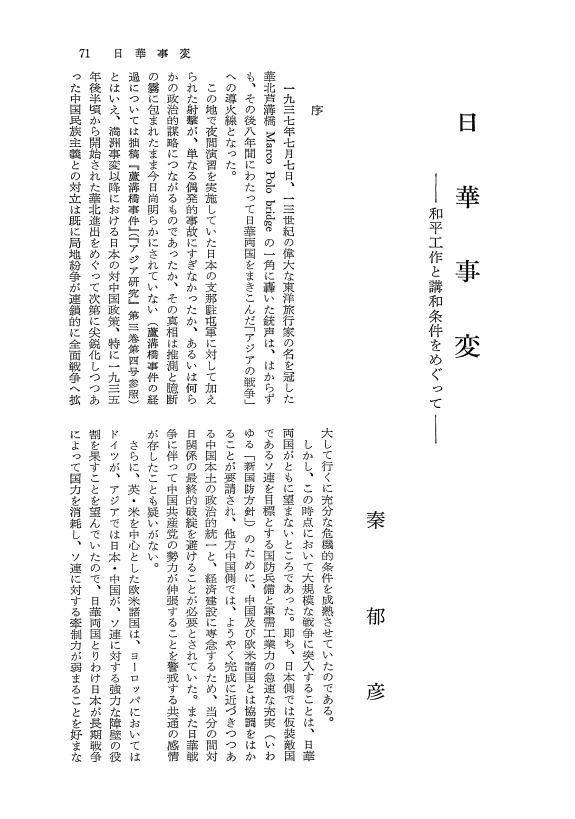34 0 0 0 草原の国境紛爭 : 第一次ノモンハン事件
- 著者
- 秦 郁彦
- 出版者
- 日本大学
- 雑誌
- 政経研究 (ISSN:02874903)
- 巻号頁・発行日
- vol.48, no.4, pp.481-516, 2012-03
7 0 0 0 ノモンハン戦の総括
- 著者
- 秦 郁彦
- 出版者
- 日本大学
- 雑誌
- 政経研究 (ISSN:02874903)
- 巻号頁・発行日
- vol.50, no.1, pp.107-153, 2013-06-25
7 0 0 0 OA ロバート・ビュートー著『東条と日米戦争』
- 著者
- 秦 郁彦
- 出版者
- JAPAN ASSOCIATION OF INTERNATIONAL RELATIONS
- 雑誌
- 国際政治 (ISSN:04542215)
- 巻号頁・発行日
- vol.1961, no.17, pp.130-133, 1961-12-15 (Released:2010-09-01)
5 0 0 0 旧日本軍の兵食--コメはパンに敗れた? (特集 軍事と衛生)
- 著者
- 秦 郁彦
- 出版者
- 錦正社
- 雑誌
- 軍事史学 (ISSN:03868877)
- 巻号頁・発行日
- vol.46, no.2, pp.4-26, 2010-09
3 0 0 0 OA 冷戦初期のアメリカ軍事戦略
- 著者
- 秦 郁彦
- 出版者
- JAPAN ASSOCIATION OF INTERNATIONAL RELATIONS
- 雑誌
- 国際政治 (ISSN:04542215)
- 巻号頁・発行日
- vol.1982, no.70, pp.47-66,L5, 1982-05-22 (Released:2010-09-01)
- 参考文献数
- 63
While the United Nations were devoting their last efforts towards the defeat of the Axis Powers, strategists within the U. S. Joint Chiefs of Staff had started to prepare for the “next war.” The USSR appeared as the most probable enemy in the war plans from the fall of 1945. Rapid demobilization and resulting reorganization of American armed forces, however, curtailed effective deterrence toward the USSR which maintained relatively superior forces along the “Iron Curtain.”Official declaration of the Cold War by President Truman in 1947 accelerated the rapid strengthening of the U. S. armed forces and a number of emergency war plans, short and long term, were drafted.In this article, the author has endeavoured to trace the evolution of the American strategy toward the USSR between 1945 and 1949, based chiefly on the JCS Official History. Special attention has been paid to the changing role of nuclear weapons within the overall strategy.The Far East was always given low priority by war planners and it led to the retreat of the U. S. defense perimeter in Asia since the “loss of China” in the fall of 1949. Japan under the occupation was, however, enjoying calm and peaceful days.
3 0 0 0 OA 明治期以降における日米太平洋戦略の変遷
- 著者
- 秦 郁彦
- 出版者
- JAPAN ASSOCIATION OF INTERNATIONAL RELATIONS
- 雑誌
- 国際政治 (ISSN:04542215)
- 巻号頁・発行日
- vol.1968, no.37, pp.96-115, 1968-10-28 (Released:2010-09-01)
- 参考文献数
- 54
3 0 0 0 OA ノモンハン事件の終結
- 著者
- 秦 郁彦
- 出版者
- 日本大学
- 雑誌
- 政経研究 (ISSN:02874903)
- 巻号頁・発行日
- vol.49, no.4, pp.395-435, 2013-03-05
2 0 0 0 OA ハルハ河畔の攻防 : 第二次ノモンハン事件
- 著者
- 秦 郁彦
- 出版者
- 日本大学
- 雑誌
- 政経研究 (ISSN:02874903)
- 巻号頁・発行日
- vol.49, no.1, pp.73-118, 2012-06-30
1 0 0 0 OA 日華事変 -和平工作と講和条件をめぐって-
- 著者
- 秦 郁彦
- 出版者
- JAPAN ASSOCIATION OF INTERNATIONAL RELATIONS
- 雑誌
- 国際政治 (ISSN:04542215)
- 巻号頁・発行日
- vol.1960, no.11, pp.71-84, 1960-01-31 (Released:2010-09-01)
1 0 0 0 いわゆる「百人斬り」事件の虚と実(1)
- 著者
- 秦 郁彦
- 出版者
- 日本大学法学会
- 雑誌
- 政経研究 (ISSN:02874903)
- 巻号頁・発行日
- vol.42, no.1, pp.117-149, 2005-05
1 0 0 0 「子供の姓」を論じない夫婦別姓論議の欺瞞 (特集 偽善の逆襲)
1 0 0 0 ノモンハン戦敗北人事の決算 : 無断退却から自決強要まで
- 著者
- 秦 郁彦
- 出版者
- 錦正社
- 雑誌
- 軍事史学 (ISSN:03868877)
- 巻号頁・発行日
- vol.49, no.1, pp.71-95, 2013-06
1 0 0 0 第二次大戦期の配属将校制度
- 著者
- 秦 郁彦
- 出版者
- 錦正社
- 雑誌
- 軍事史学 (ISSN:03868877)
- 巻号頁・発行日
- vol.40, no.4, pp.4-25, 2005-03
1 0 0 0 OA 華北分離工作の失敗(2)
- 著者
- 秦 郁彦
- 出版者
- 一般財団法人 アジア政経学会
- 雑誌
- アジア研究 (ISSN:00449237)
- 巻号頁・発行日
- vol.6, no.1, pp.41-61, 1959 (Released:2014-09-15)
1 0 0 0 梅津・何応欽協定経緯
- 著者
- 秦 郁彦
- 出版者
- Japan Association for Asian Studies
- 雑誌
- アジア研究 (ISSN:00449237)
- 巻号頁・発行日
- vol.4, no.2, pp.65-114, 1957
1 0 0 0 ある韓国空軍英雄の数奇な運命
- 著者
- 秦 郁彦
- 出版者
- 中央公論新社
- 雑誌
- 中央公論 (ISSN:05296838)
- 巻号頁・発行日
- vol.109, no.5, pp.p320-332, 1994-05





